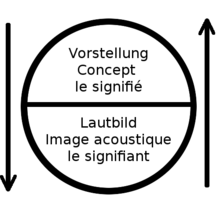Presentation and sound image
In order to explain how the sign works, Ferdinand de Saussure introduces the distinction between sound image and imagination (French "image acousticue" and "concept"). These stand in a designation relation: the sound image is indicative, the idea what is designated by it (see the image on the right). Correspondingly, one speaks of signifier and signified (French "signifiant" and "signifié", Latin "signans" and "signatum"). De Saussure understands the factual connection between sound image and imagination as a hard, indissoluble and uninfluenceable one, although, according to his arbitrariness thesis, this connection is initially determined arbitrarily. Only a few onomatopoietics are an exception to this.
Simplified, the signifier is something indicative and the signified something designated or the content side of a sign , that is, the conceptual image - the concept , the meaning or the meaning - to which a specific signifier is referred (referred to) . The sequence of letters or sounds, the signifier, is connected with the meaning, the signified. For example: "Hat" consists of a sequence of three letters or sounds (signifier) and the associated meaning "type of headgear" (signified).
This hard dichotomization between the two halves of the word process had a major impact on the development of linguistics and was essential for the birth of structuralism , also for the establishment of semiotics / semiology , especially where this contrasted the dyadic with a triadic structure. Precisely because the cuts - such as between diachrony and synchronicity - were made very strictly, it was possible to show clear linguistic structures, if not to create them at all. Only then did it become possible to develop methods that could be applied to individual, clearly definable aspects (e.g. sound change ) and produced verifiable results - similar to the natural sciences. Ferdinand de Saussure thus suggested the formalized description of language, which was first implemented by Noam Chomsky (Syntactic Structures 1957).
Of course, there were also other prehistory, which at times remained aside due to the sometimes idiosyncratic nature of de Saussure's performance and the corresponding reception. The language barriers between the young German grammarians and de Saussure played less a role than those between him and the Anglo-Saxon region, where the German works were largely unknown. But it was probably also the completely opposite style compared to that of Paul Hermann, who had already problematized de Saussure's new ideas in his extremely opulent works, but not by restricting them to so few main theses and such concise images for them Blackboard in the lecture hall.
For a somewhat further search for the models of this distinction one can go back to the painting of Paul Cézanne , who explained in his letters the change in his new conception of art by saying that he did not paint trees, but pictures. A turning point on a scale that had brought Kant's critical work to philosophy. In the exact sciences and the prehistory of analytical philosophy , this turning point was operated by Gottlob Frege , who distinguished between meaning and meaning in a similar radicalism . In his conceptual writing from 1879 he had already developed a mathematical linguistic system that was in contrast to phonetic writing.
Saussure's distinction had a great influence on many cultural areas and sciences in the 20th century.
source
- Ferdinand de Saussure , Cours de linguistique générale, éd. Payot. 1913 (posthumously), German from de Gruyter
